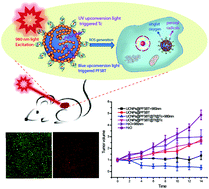Multilayered upconversion nanocomposites with dual photosensitizing functions for enhanced photodynamic therapy†
Abstract
The energy transfer from upconversion nanoparticles (UCNPs) to photosensitizers has been widely used for generating reactive oxygen species (ROS) in photodynamic therapy (PDT) by near infrared (NIR) excitation. However, the poor spectral overlap of lanthanide ions and conventional photosensitizers leads to low PDT efficiency. In this study, we construct a multilayered upconversion nanoplatform with dual photosensitizers to efficiently use the UV and visible upconversion emissions in NIR-responsive PDT. The nanoplatform consists of three functional layers, which are the upconversion nanoparticle as a core, and light-sensitive conjugated polymer and apo-transferrin-titanocene (Tf@Tc) as shells. Under NIR irradiation, apparent energy transfer occurs from the core to the polymer and Tc components in the shell, producing reactive oxygen species and free radicals for cancer cell killing. In vitro cellular assays show the synergistic therapeutic effect of the conjugated polymer and Tc as photosensitizers. In vivo animal studies show that tumor growth is significantly inhibited in the mice receiving the theranostic platform and NIR irradiation. Based on these observations, the multilayered upconversion nanocomposites can find potential applications in NIR-mediated anti-tumor therapy.

- This article is part of the themed collection: 2017 Journal of Materials Chemistry B HOT Papers


 Please wait while we load your content...
Please wait while we load your content...